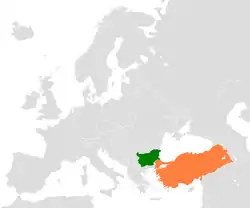Bulgaria–Turkey border
The Bulgaria–Turkey border (Bulgarian: Границата между България и Турция, romanized: Granitsata mezhdu Bŭlgariya i Turtsiya,Turkish: Bulgaristan–Türkiye sınırı) is a 269 km (167 mi) long international border between the Republic of Bulgaria and the Republic of Turkey. It was established by the Treaty of San Stefano in 1878 as an inner border within the Ottoman Empire. The current borders are defined by the Treaty of Constantinople (1913) and the Bulgarian–Ottoman convention (1915). The border was reaffirmed by the Treaty of Lausanne ten years later, though Bulgaria was not a party to the latter treaty as it had earlier ceded to Greece that part of its border with Turkey which was modified by the Bulgarian-Ottoman convention.
| Bulgaria-Turkey border Границата между България и Турция Bulgaristan–Türkiye sınırı | |
|---|---|
 | |
| Characteristics | |
| Entities | |
| Length | 269 km (167 mi)[1] |
| History | |
| Established | 3 March 1878 Signing of the Treaty of San Stefano at the end of the Russo-Turkish War (1877–1878) |
| Current shape | 6 August 1924 Signing of the Treaty of Lausanne at the end of the Turkish War of Independence |
| Treaties | Treaty of San Stefano, Treaty of Berlin, Tophane Agreement, Treaty of London, Treaty of Constantinople, Treaty of Sèvres, Treaty of Lausanne |
Border barrier
In response to the European migrant crisis, Bulgaria erected a border barrier to halt the influx of illegal crossings. As of June 2016, nearly 146 kilometres (91 mi) of the 166 kilometres (103 mi) planned barrier were constructed.[2]
In January 2014, Bulgaria started construction of a 30 km (19 mi) long security fence along its border with Turkey to contain a surge of migrants from the Middle East and North Africa.[3] Standing 10 ft (3.0 m) tall and fortified with razor wire coils, the fence covers the least visible section of the border between the Lesovo border checkpoint and the village of Golyam Dervent. The Bulgarian Army completed the protective barrier in July 2014 at a cost of around €5 million.[4] As a result of the new fence, illegal crossing attempts in the vicinity of the installation have decreased by seven times. Turkey’s ambassador to Bulgaria Suleyman Gokce has expressed dissatisfaction with the border barrier adding that it creates discontent and gives reason to "reflect on the political message," that the fence is sending.[5]
At the beginning of 2015, the government announced a 130 km (81 mi) extension to the barbed wire border fence in order to completely secure the land border. Prime Minister Boyko Borisov described the extension as "absolutely necessary," in order to prevent persons from illegally entering the European Union member state.[6] The Bulgarian Parliament has decided to continue construction of the fence at the border with Turkey without launching a public procurement procedure because of the need to safeguard national security.[7] This final section of the fence completely seals off Bulgarian border with Turkey.[8] As of March 2016, nearly 100 kilometres (62 mi) of the 166 kilometres (103 mi) planned barrier were constructed.[9] As of June 2016, 146 kilometres (91 mi) of the barrier were constructed.[2]
Crossings
There are three crossings along the entire border, two for vehicular traffic and one for vehicular and rail traffic. The busiest of three, Kapıkule, is among the busiest border checkpoints in the world.
| Province | Province | Opened | Route in Turkey | Route in Bulgaria | Status | ||
|---|---|---|---|---|---|---|---|
| Kapıkule | Edirne | Kapitan Andreevo | Haskovo | 4 September 1953 | Pehlivanköy–Svilengrad railway |
Pehlivanköy–Svilengrad railway |
Open |
| Hamzabeyli | Edirne | Lesovo | Yambol | 22 November 2004 | Open | ||
| Dereköy | Kırklareli | Malko Tarnovo | Burgas | 18 July 1969 | Open |
References
- "Türkiyenin Komşuları ve Coğrafi Sınırları". 14 February 2016. Archived from the original on 14 February 2016.
- Migrant crisis: Bulgaria tightens border with Turkey. June 3, 2016. BBC News.
- Lyman, Rick (2015-04-05). "Bulgaria Puts Up a New Wall, but This One Keeps People Out". New York Times. Retrieved April 12, 2015.
- "Bulgarian Defense Minister: Border Fence to be Finished in June". 2014-05-14. Retrieved April 12, 2015.
- "Turkey's Ambassador to Bulgaria Voices Dissatisfaction with Border Fence". 2015-05-31. Retrieved May 31, 2015.
- "Bulgaria to extend fence at Turkish border to bar refugee influx". Retrieved April 12, 2015.
- "Parliament OKs Building of Border Fence Without Public Procurement". Retrieved April 12, 2015.
- Caroline Mortimer. Bulgaria builds final part of razor wire fence to keep out refugees. The Independent. 4 August 2015.
- Editorial, Reuters (2016-03-25). "Bulgaria says ready to erect fence on border with Greece". Reuters. Retrieved 2017-12-02.